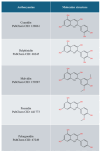Anthocyanins and Anthocyanidins in the Management of Osteoarthritis: A Scoping Review of Current Evidence
- PMID: 40143080
- PMCID: PMC11944859
- DOI: 10.3390/ph18030301
Anthocyanins and Anthocyanidins in the Management of Osteoarthritis: A Scoping Review of Current Evidence
Abstract
Background/Objectives: The consumption of food rich in anthocyanins, a natural pigment found in plants, has been associated with improved joint health. However, systematic efforts to summarise the effects of anthocyanins and their deglycosylated forms, anthocyanidins, in managing osteoarthritis (OA) are lacking. This scoping review aims to comprehensively summarise the current evidence regarding the role of anthocyanins and anthocyanidins in OA management and highlights potential research areas. Methods: A comprehensive literature search was performed using PubMed, Scopus, and Web of Science in January 2025 to look for primary studies published in English, with the main objective of investigating the chondroprotective effects of anthocyanins and anthocyanidins, regardless of their study designs. Results: The seven included studies showed that anthocyanins and anthocyanidins suppressed the activation of inflammatory signalling, upregulated sirtuin-6 (cyanidin only), and autophagy (delphinidin only) in chondrocytes challenged with various stimuli (interleukin-1β, oxidative stress, or advanced glycation products). Anthocyanins also preserved cartilage integrity and increased the pain threshold in animal models of OA. No clinical trial was found in this field, suggesting a translation gap. Conclusions: In conclusion, anthocyanins and anthocyanidins are potential chondroprotective agents, but more investigations are required to overcome the gap in clinical translation.
Keywords: cartilage; inflammation; joint; osteoarthrosis; pigments.
Conflict of interest statement
The authors declare no conflicts of interest. The funders had no role in the design of the study; in the collection, analyses, or interpretation of data; in the writing of the manuscript; or in the decision to publish the results.
Figures



References
-
- Wenjian Zhao Y.L., Wang Y., Chin K.-Y. Osteoarthritis: An integrative overview from pathogenesis to management. Malays. J. Pathol. 2024;46:369–378. - PubMed
-
- Cherniavskyi V.V., Baylo A.E., Onyshuk L.O., Tishchenko V.V. Critical evaluation of the current role of SYSADOA in the management of osteoarthritis (literature review) Pain Jt. Spine. 2024;14:96–105. doi: 10.22141/pjs.14.2.2024.423. - DOI
-
- Atthakorn J., Chaturong P. Complications after Total Knee Arthroplasty: Stiffness, Periprosthetic Joint Infection, and Periprosthetic Fracture. In: Alessandro Z., Hechmi T., Eric L., editors. Arthroplasty. IntechOpen; Rijeka, Croation: 2022. p. Ch. 8.
Publication types
Grants and funding
LinkOut - more resources
Full Text Sources
Miscellaneous

